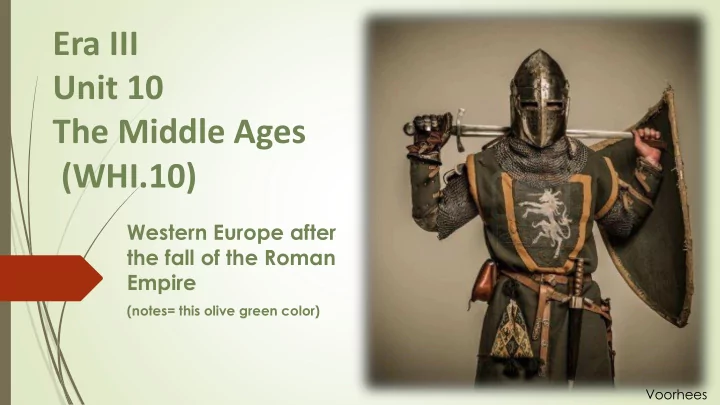

Era III Unit 10 The Middle Ages (WHI.10) Western Europe after the fall of the Roman Empire (notes= this olive green color) Voorhees
I. Intro; Roman Empire West v. East: The East The West Middle Ages- Feudalism Byzantine Empire- Emperors Roman Catholic Christianity Eastern Orthodox Christianity Latin language Greek language Pope as religious leader Patriarch as religious leader Rome as capital Constantinople as capital
The student will apply social science skills to understand Western Europe during the Middle Ages from about 500 to 1000 A.D. (C.E.) in terms of its impact on Western civilization by a) locating and describing the societies of Western Europe during the Middle Ages in time and place;
II. Foundations of early medieval society Coming from the Roman Empire: Classical heritage of Rome Christian beliefs Coming from invading barbarians: Customs of Germanic tribes
III. Location Cultural Forces: Scandinavia — Vikings England — Angles and Saxons Present-day France and Germany — Franks
WHI.10a) Essential Understandings After the collapse of the Western Roman Empire, Germanic and Scandinavian kingdoms emerged as powerful forces. Germanic civilization was influenced by various cultural forces as it established itself in Europe.
The student will apply social science skills to understand Western Europe during the Middle Ages from about 500 to 1000 A.D. (C.E.) in terms of its impact on Western civilization by b) describing the social, religious, and cultural development of the Franks, with emphasis on the Age of Charlemagne;
IV. Social, religious, and cultural development during the Age of Charlemagne Franks emerged as a force in Western Europe. The Pope crowned Charlemagne emperor. Power of the Church was established in political life.
Franks emerged as a force in Western Europe. Clovis power and extent of Frankish Kingdom grew Converted to Christianity, beginning a close connection between Frankish kings and the papacy (the pope) Made Paris the capital of his kingdom
Charles “The Hammer” Martel
Charles Martel Halted the Muslim expansion into Western Europe at the Battle of Tours 732 CE
Pepin the Short Son of Charles Martel Rex (King) Pepin Strict Catholic Protected Catholic Church from invading Lombards
Charlemagne Son of Pepin the Short (Grandson of Charles Martel) Establishes the Frankish Kingdom to its greatest extent “Carolingian Empire” The Pope crowned Charlemagne emperor Christmas Day 800 CE Makes an alliance with the pope
Age of Charlemagne, continued… Classical Roman Latin was revived as the language of scholars but disappeared as a language of everyday life, replaced by French, Italian, Spanish, or other languages. Most of Western Europe was included in the new empire. Churches, roads, and schools were built to unite the empire.
WHI.10b) Essential Understandings Frankish kings used military power to expand their territory. The alliance between Frankish kings and the Church increased papal authority and influence in Western Europe.
The student will apply social science skills to understand Western Europe during the Middle Ages from about 500 to 1000 A.D. (C.E.) in terms of its impact on Western civilization by c) explaining the social, religious, and cultural development of the Magyars and Anglo-Saxons;
V. Social, religious, and cultural development Angles and Saxons migrated to England in the fifth century. The Magyars migrated to central Europe in the tenth century. Tribal units were led by chieftains.
V. Social, religious, and cultural development Invasions disrupted trade; towns declined. The Angles, Saxons, and Magyars gradually converted to Christianity. After converting to Christianity, the Angles, Saxons, and Magyars adopted literacy.
Barbarians/ Germanic Peoples Become Europe From a) Angles To Continental and Saxons England Europe To From Central b) Magyars Asia Hungary From c) Vikings To Russia Scandinavia
WHI.10c) Essential Understandings Invasions by Angles, Saxons, and Magyars disrupted the social, economic, and political order of Europe.
The student will apply social science skills to understand Western Europe during the Middle Ages from about 500 to 1000 A.D. (C.E.) in terms of its impact on Western civilization by d) describing the social, religious, and cultural patterns of the Vikings;
VI. Social, religious, and cultural development The Viking attacks took place mostly in the 9th and 10th centuries. Tribal units were led by chieftains. Lack of arable land led to exploration and invasion. Invasions disrupted trade; towns declined.
Social, religious, and cultural development The Vikings observed a polytheistic religion, but gradually converted to Christianity.
Social, religious, and cultural development Viking attacks contributed to the collapse of the Frankish Empire founded by Charlemagne. Vikings settled in the areas known today as Russia, Iceland, and Greenland, and briefly in North America. Eastern European sea and river trade.
WHI.10d) Essential Understandings Invasions by Vikings disrupted the social, economic, and political order of Europe.
Feudalism- a system to protect and unite POLITICAL/ SOCIAL feudalism developed to protect people in a time of war and anarchy it worked pretty good and held things together When feudalism proved its worth on a local basis, kings and emperors adopted it to strengthen their monarchies
The Manor System- a system to sustain and cooperation ECONOMIC/ SOCIAL Manorialism developed to sustain people in a time of decreased trade and depression Agricultural society The manor= the main house grounds surrounding village type aspects farming community
Feudalism and Manor System: king knights/ church officials merchants peasants serfs
Walled city of Carcassonne (the Cit é)
Recommend
More recommend